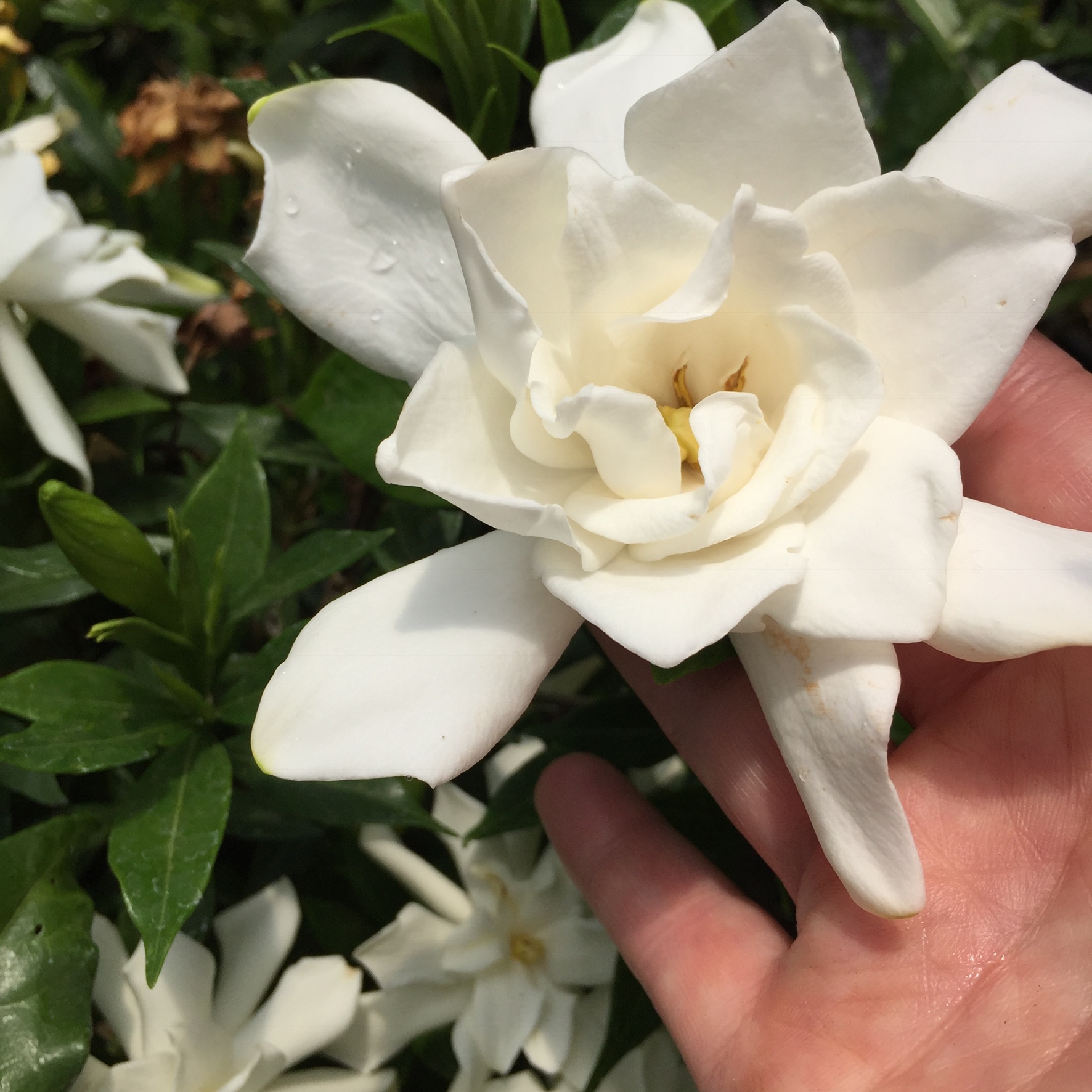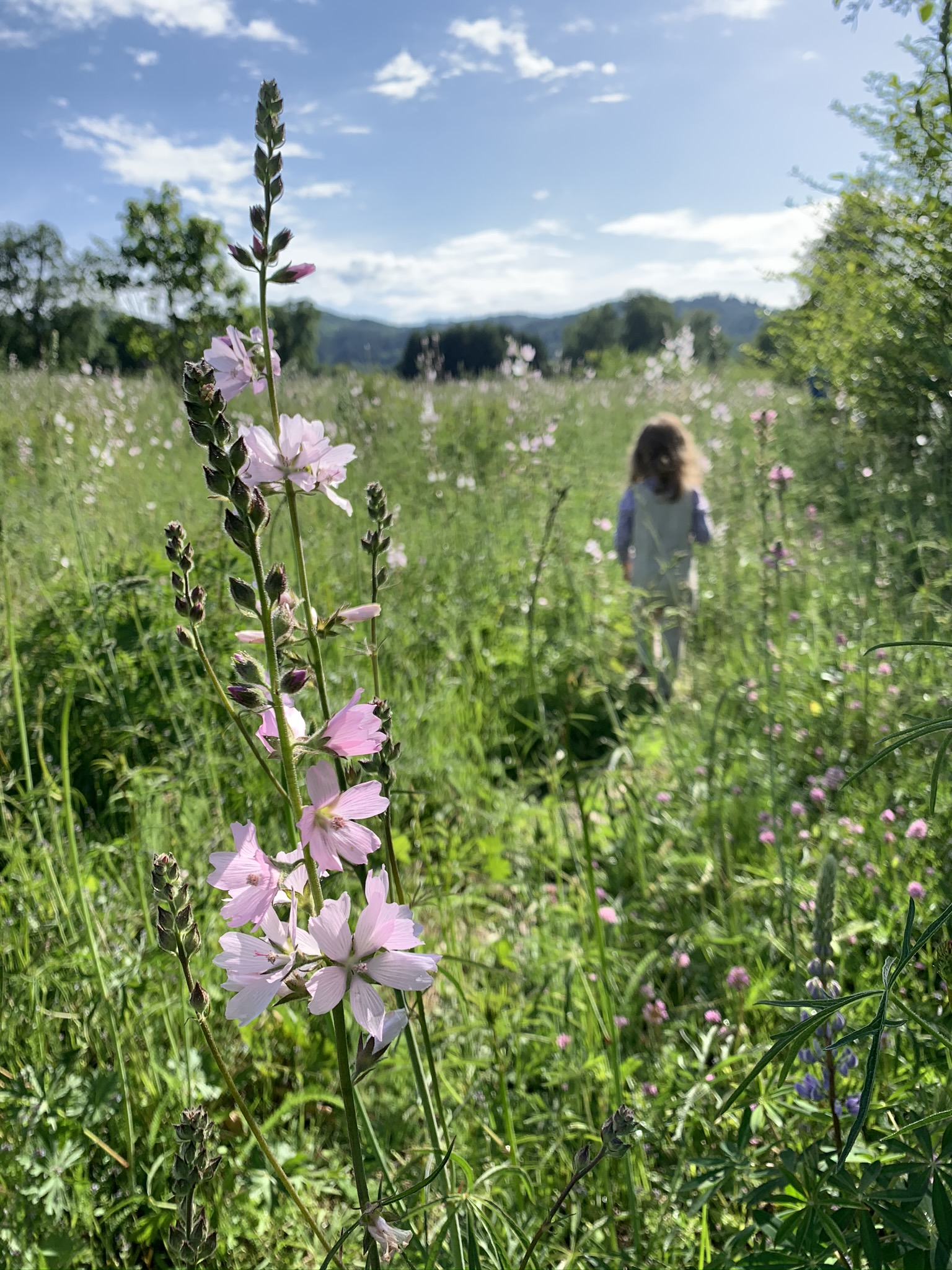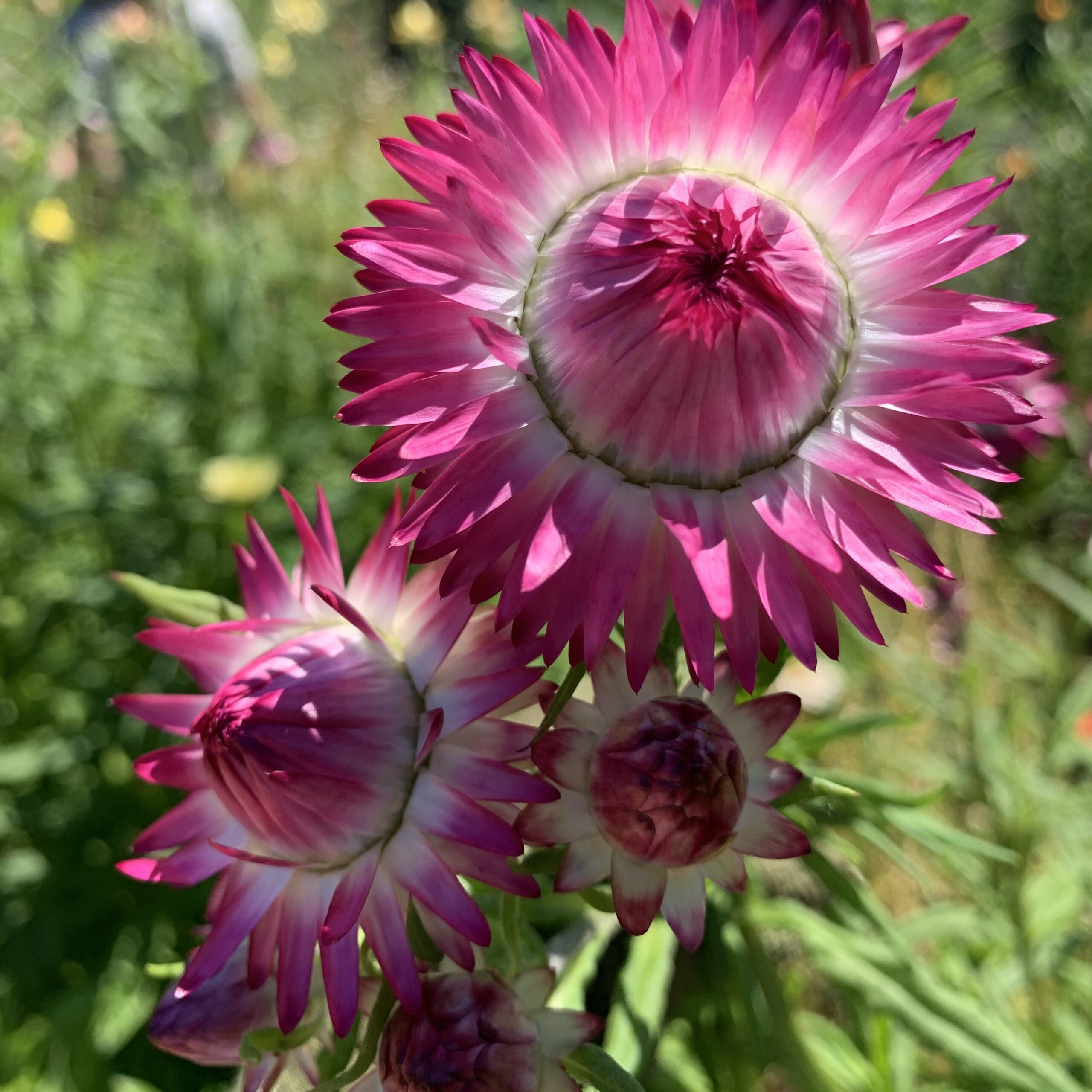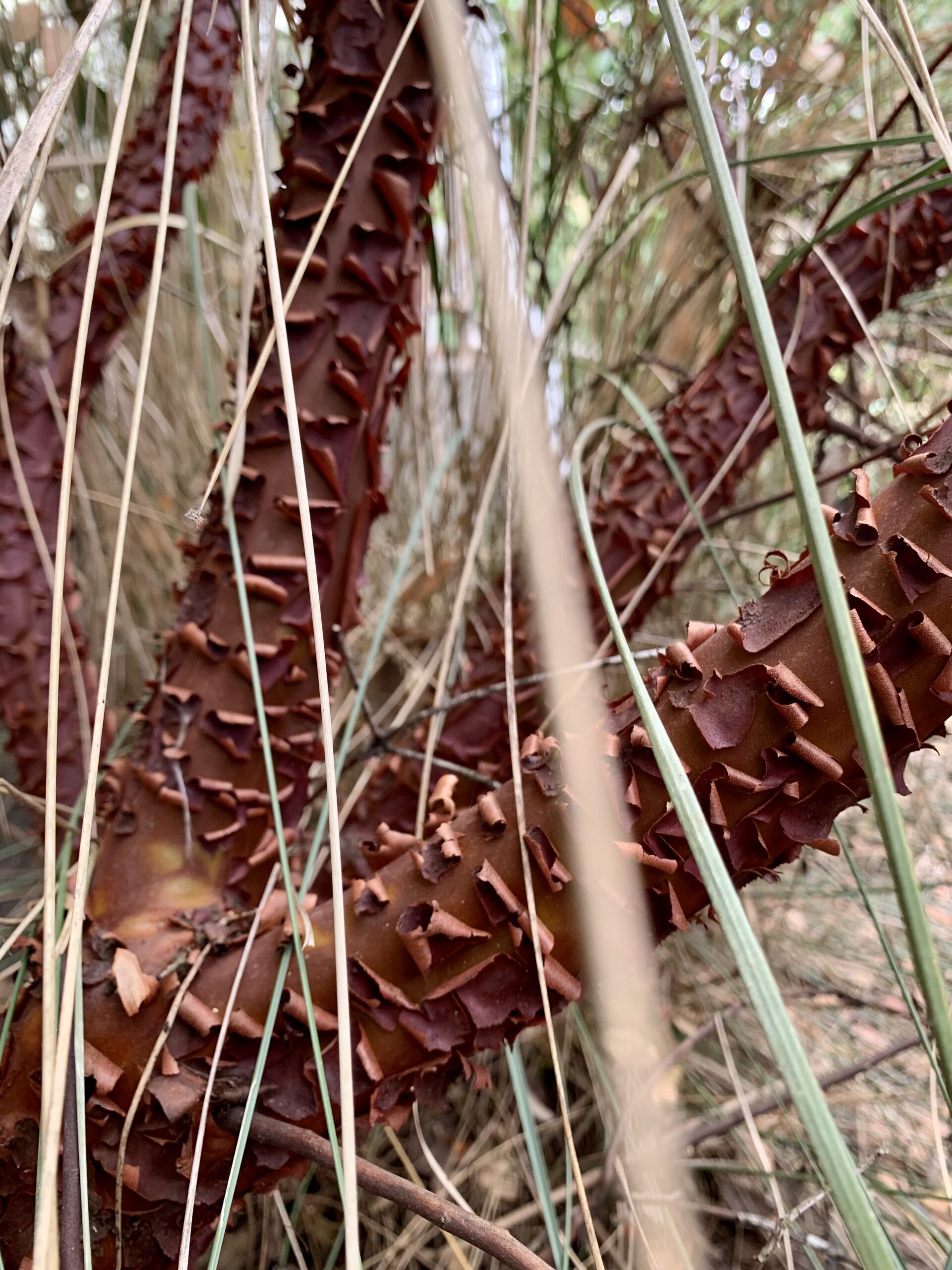Favorite Plants of
Pacific Plant People
Member Profile
Adinah D’Andrea

Adinah D’Andrea has been propagation lead at Xera Plants Inc. for the past 15 years. Xera grows a broad selection of plants less common in the trade but specializes in climate adapted varieties that tolerate PNW winter wet/summer dry cycles. Over the years the production catalog has evolved to include an expansive offering of regionally native species including ephemeral spring annuals, sedges and grasses rare in cultivation. She lives with her family in Portland, Oregon, where she’s been orienting her two daughters towards a life rich in horticultural and ecological exposure. Some of the favorite spots they frequent are a restored native meadow under a canopy of mighty Oregon White Oak, winding trails through towering mixed conifer forests dripping with Usnea and our urban community orchard that somehow sustains the footfall of half feral children.

Gardenia jasminoides ‘Chuck Hayes’

Verbascum bombyciferum ‘Arctic Summer’

Sidalcea campestris 'Willamette Checker Mallow'

Xerochrysum bracteatum 'Starflower'
Arctostaphylos manzanita ‘St. Helena’
Drought Resilient
Plant Family
Ericaceae
Genus
Arctostaphylos
Species
Arctostaphylos manzanita ‘St. Helena’
Manzanita are quintessentially western shrubs. There are over 60 species and countless hybrids occurring from Canada into Mexico, from the beach up into the mountains. My childhood secret garden hideaways were under the canopy of A. viscida groves in the Siskiyou foothills and I adore that it’s the same for my kids, only under manzanita we planted in our urban garden. Of course there is an endless array of sturdy shrubs that kids can disappear under, slip into their imaginative realm and make a place of their own. Manzanita are special in that not only do they have a bit of a mythical quality in their form, they also have so much to offer. From the tiny bell flowers that rain down like confetti to be served as cups at fairy tea parties to the “little apples” I’ve witnessed be gathered as ammo, macerated into fermented mush, floated in mud stew and magic potions and collected as treasured currency. They are a wonderful backdrop to free, independent open-ended play.

Water Use
Drought tolerant. No water necessary once established.
Conditions When It Thrives
Hot aspects, full sun. Good air circulation. Minimal or preferably no water once established.
Ecosystem Services
Early nectar source for hummingbirds. A favorite for bumblebees and worthy of the first flight of the season for honeybees.
Native To
A. manzanita occurs primarily in the northern and central Sierra Nevada foothills and north coast range.
Geographic Range
Hardy to USDA Zn7b, 10°-5° F
Availability
Locally available at Xera Plants Inc.
Height & Habit
Broad, rounded arboreal form. Rapid, uniform growth. 10’ x 10’ average at maturity.
Special Features
Exceptionally sculptural branching habit with exfoliating mahogany bark.
Why They Love It
There are many specimen worthy selections of varying stature, with their sinuous sculptural forms. I chose A. manzanita ‘St. Helena’ as a notable variety as it seems to hold its own through inclement weather and flush out rapidly into a glorious arboreal form.
Seasonal Appearance/Dormancy
Silver gray evergreen foliage. White ericaceous bell flowers in late winter followed by chubby berries ripening to russet brown in late summer.
Advice
Gardenia jasminoides ‘Chuck Hayes’
Drought Resilient
Plant Family
Rubiaceae
Genus
Gardenia
Species
Gardenia jasminoides ‘Chuck Hayes’
Certainly one of the ways a garden can influence us is the resonance of smell. Olfactory memory of fragrant blooms lasts a lifetime for many of us. Fragrance in the garden is such a wonderful sensory experience to share with kids and often that memory is a lifelong connection to a place in time. Resinous foliage or pungent blooms alike, bonus points for things that can be plucked at will on a moment's impulse. It’s an opportunity not to be missed to include something fragrant when gardening with children in mind.

Water Use
Average summer irrigation.
Conditions When It Thrives
Rich soil. Regular irrigation. Full sun to full shade in locations protected from rapid temperature shifts. Radiating warmth and consistent temperatures seem to treat them well. Wonderful in containers, sheltered during threatening winter temperatures
Ecosystem Services
Native To
G. jasminoides in native to China and Japan.
Geographic Range
Withstanding temperatures as low as USDA Zn7b 10°-5° F
Availability
Locally available at Xera Plants Inc.
Height & Habit
Dense shrub, 3-4’ tall and wide.
Special Features
Exceptional cold hardiness. Intensely fragrant, double white double blooms
Why They Love It
G. jasminoides ‘Chuck Hayes’ has the most pungently dreamy scent with sizable, buttery white, corsage worthy blooms. My girls love tucking them behind their ears in high summer, floating them in the bathtub and our household ritual of stowing them under the pillows to fulfill a wish and bestow sweet dreams. Pure nostalgia.
Seasonal Appearance/Dormancy
Evergreen. Blooming in summer.
Advice
Verbascum bombyciferum ‘Arctic Summer’
Drought Resilient
Plant Family
Plantaginaceae
Genus
Verbascum
Species
Verbascum bombyciferum ‘Arctic Summer’
Verbascum makes the list because few things are as exciting for kids in the garden as rapid, measurable growth. Plants are animate too! This one tops the charts with its daily climb skyward. Ethereal tendrils of gossamer fuzz winding their way curiously towards the light! My kids adore these giant silver mullein as much as I do. Especially when they are wildly juiced up and robust, in the squirrelly phase at peak bloom. Giant towers of Echium are a contender if the climate allows, or witnessing an Agave rocket up into a candelabra.

Water Use
Average irrigation for best show.
Conditions When It Thrives
Full sun in rich, well drained soil. Heat loving. Tolerates drought and lean soils but is culturally affected, reaching full glory and impressive heights with richer soil and regular summer irrigation.
Ecosystem Services
Native To
Turkey
Geographic Range
Adaptable and cold hardy. Possible to overwinter to USDA Zn4b, -20° to -25°F
Availability
Locally available at Xera Plants Inc.
Height & Habit
Most often biennial. First year it produces a 2’ wide, beautifully symmetrical rosette. Second year expect a towering bloom spike to 6’ or much more depending on growing conditions.
Special Features
Rapid growth! Strikingly architectural, especially en mass.
Why They Love It
Also notable, observing V. thapsus with kids is a gateway for greater learning about people and plant migration, Eurasian medicinals, invasive species, the disruption of native land and the displacement of native species. Plants dig deep!
Seasonal Appearance/Dormancy
Large fuzzy soft silver sage leaves. Densely downey flower spike begins to emerge in mid spring. The spike will continue to branch, produce vivid yellow blooms into late summer and persist until weather allows.
Advice
Sidalcea campestris 'Willamette Checker Mallow'
Drought Resilient
Plant Family
Malvaceae
Genus
Sidalcea
Species
Sidalcea campestris 'Willamette Checker Mallow'
A true locally native perennial, Sidalcea campestris is so lovely in a soft and naturalistic design. It combines perfectly with sprays of grasses, other wildflower companions such as clarkia, lupine, and yarrow, as we might have once seen it in vast meadows throughout the Willamette Valley. Native plants are such great educational tools for kids to begin to understand concepts of symbiosis and mutualism. Adding regionally native plants to the home garden is a wonderful way for kids to grow a deeper sense of place, recognition and relation to the land they inhabit. Deepening this awareness and relation to land will hopefully amplify and sustain their interests in stewardship and regard for an environment in balance. Willamette checker mallow is a special one for us!

Water Use
Drought tolerant though thrives with average summer water.
Conditions When It Thrives
Full sun to light shade. Tolerates heavy clay, lean soil and summer drought although rich garden culture with average summer water will increase bloom time and shorten dormancy. Very adaptable
Ecosystem Services
Localized coevolution with many native pollinators. Host plant and nectar source for rare native butterflies.
Native To
Oregon, specifically Willamette Valley native. Only very small populations extend beyond historic savannah and meadows of the Willamette Valley floor.
Geographic Range
Naturally occurring in heavy clay soil and persisting through summer drought. USDA Zn4b, -20° to -25° F
Availability
Locally available at Xera Plants Inc.
Height & Habit
Low clump forming perennial. 20-40” graceful spikes of blush pink mallow blooms.
Special Features
Ideal non-spreading, non-aggressive, rugged yet showy native perennial for urban gardens.
Why They Love It
Seasonal Appearance/Dormancy
Blooming spring into midsummer, May-July. Winter dormant, often with sparse semi-evergreen foliage.
Advice
Xerochrysum bracteatum 'Starflower'
Drought Resilient
Plant Family
Asteraceae
Genus
Xerochrysum
Species
Xerochrysum bracteatum 'Starflower'
Strawflower is a classic not to be forgotten! Growing annual flowers and vegetables from seed to harvest is so accessible and educational for kids. It’s integral to gardening to offer them the experience of agency and responsibility, allowing them to do what they will with their flowers! It’s been helpful for us to have a lot of the same variety, a more consistent source for the mud kitchen or the craft of the moment. Annual cut flowers continue to grow in popularity with the flower farmer buzz, making available a lot of fun and unusual varieties. Strawflower is an undeniable favorite with its vibrantly whorled rays of curiously tactile, crunchy, bristly blooms.

Water Use
Low to average summer water for best blooms.
Conditions When It Thrives
Full sun. Quite forgiving of lean soil and low water, although they thrive with added fertility and regular summer water.
Ecosystem Services
Certainly a landing pad for many pollinators.
Native To
Australia
Geographic Range
Summer annual.
Availability
Widely available by seed. Commonly available in vivid jewel-toned seed mixes, though breeders have selected many beautifully sophisticated single color strains.
Height & Habit
Plant densely, one plant per square foot is fine. 3’ tall average.
Special Features
Paper-like bracts resemble petals. Great as a cut flower, exceptional as a dried flower.
Why They Love It
Seasonal Appearance/Dormancy
Blooms in high summer until a killing frost.
Advice
Arctostaphylos manzanita ‘St. Helena’
Drought Resilient
Plant Family
Ericaceae
Genus
Arctostaphylos
Species
Arctostaphylos manzanita ‘St. Helena’
Manzanita are quintessentially western shrubs. There are over 60 species and countless hybrids occurring from Canada into Mexico, from the beach up into the mountains. My childhood secret garden hideaways were under the canopy of A. viscida groves in the Siskiyou foothills and I adore that it’s the same for my kids, only under manzanita we planted in our urban garden. Of course there is an endless array of sturdy shrubs that kids can disappear under, slip into their imaginative realm and make a place of their own. Manzanita are special in that not only do they have a bit of a mythical quality in their form, they also have so much to offer. From the tiny bell flowers that rain down like confetti to be served as cups at fairy tea parties to the “little apples” I’ve witnessed be gathered as ammo, macerated into fermented mush, floated in mud stew and magic potions and collected as treasured currency. They are a wonderful backdrop to free, independent open-ended play.

Water Use
Drought tolerant. No water necessary once established.
Conditions When It Thrives
Hot aspects, full sun. Good air circulation. Minimal or preferably no water once established.
Ecosystem Services
Early nectar source for hummingbirds. A favorite for bumblebees and worthy of the first flight of the season for honeybees.
Native To
A. manzanita occurs primarily in the northern and central Sierra Nevada foothills and north coast range.
Geographic Range
Hardy to USDA Zn7b, 10°-5° F
Availability
Locally available at Xera Plants Inc.
Height & Habit
Broad, rounded arboreal form. Rapid, uniform growth. 10’ x 10’ average at maturity.
Special Features
Exceptionally sculptural branching habit with exfoliating mahogany bark.
Why They Love It
There are many specimen worthy selections of varying stature, with their sinuous sculptural forms. I chose A. manzanita ‘St. Helena’ as a notable variety as it seems to hold its own through inclement weather and flush out rapidly into a glorious arboreal form.
Seasonal Appearance/Dormancy
Silver gray evergreen foliage. White ericaceous bell flowers in late winter followed by chubby berries ripening to russet brown in late summer.
Advice
Gardenia jasminoides ‘Chuck Hayes’
Drought Resilient
Plant Family
Rubiaceae
Genus
Gardenia
Species
Gardenia jasminoides ‘Chuck Hayes’
Certainly one of the ways a garden can influence us is the resonance of smell. Olfactory memory of fragrant blooms lasts a lifetime for many of us. Fragrance in the garden is such a wonderful sensory experience to share with kids and often that memory is a lifelong connection to a place in time. Resinous foliage or pungent blooms alike, bonus points for things that can be plucked at will on a moment's impulse. It’s an opportunity not to be missed to include something fragrant when gardening with children in mind.

Water Use
Average summer irrigation.
Conditions When It Thrives
Rich soil. Regular irrigation. Full sun to full shade in locations protected from rapid temperature shifts. Radiating warmth and consistent temperatures seem to treat them well. Wonderful in containers, sheltered during threatening winter temperatures
Ecosystem Services
Native To
G. jasminoides in native to China and Japan.
Geographic Range
Withstanding temperatures as low as USDA Zn7b 10°-5° F
Availability
Locally available at Xera Plants Inc.
Height & Habit
Dense shrub, 3-4’ tall and wide.
Special Features
Exceptional cold hardiness. Intensely fragrant, double white double blooms
Why They Love It
G. jasminoides ‘Chuck Hayes’ has the most pungently dreamy scent with sizable, buttery white, corsage worthy blooms. My girls love tucking them behind their ears in high summer, floating them in the bathtub and our household ritual of stowing them under the pillows to fulfill a wish and bestow sweet dreams. Pure nostalgia.
Seasonal Appearance/Dormancy
Evergreen. Blooming in summer.
Advice
Verbascum bombyciferum ‘Arctic Summer’
Drought Resilient
Plant Family
Plantaginaceae
Genus
Verbascum
Species
Verbascum bombyciferum ‘Arctic Summer’
Verbascum makes the list because few things are as exciting for kids in the garden as rapid, measurable growth. Plants are animate too! This one tops the charts with its daily climb skyward. Ethereal tendrils of gossamer fuzz winding their way curiously towards the light! My kids adore these giant silver mullein as much as I do. Especially when they are wildly juiced up and robust, in the squirrelly phase at peak bloom. Giant towers of Echium are a contender if the climate allows, or witnessing an Agave rocket up into a candelabra.

Water Use
Average irrigation for best show.
Conditions When It Thrives
Full sun in rich, well drained soil. Heat loving. Tolerates drought and lean soils but is culturally affected, reaching full glory and impressive heights with richer soil and regular summer irrigation.
Ecosystem Services
Native To
Turkey
Geographic Range
Adaptable and cold hardy. Possible to overwinter to USDA Zn4b, -20° to -25°F
Availability
Locally available at Xera Plants Inc.
Height & Habit
Most often biennial. First year it produces a 2’ wide, beautifully symmetrical rosette. Second year expect a towering bloom spike to 6’ or much more depending on growing conditions.
Special Features
Rapid growth! Strikingly architectural, especially en mass.
Why They Love It
Also notable, observing V. thapsus with kids is a gateway for greater learning about people and plant migration, Eurasian medicinals, invasive species, the disruption of native land and the displacement of native species. Plants dig deep!
Seasonal Appearance/Dormancy
Large fuzzy soft silver sage leaves. Densely downey flower spike begins to emerge in mid spring. The spike will continue to branch, produce vivid yellow blooms into late summer and persist until weather allows.
Advice
Sidalcea campestris 'Willamette Checker Mallow'
Drought Resilient
Plant Family
Malvaceae
Genus
Sidalcea
Species
Sidalcea campestris 'Willamette Checker Mallow'
A true locally native perennial, Sidalcea campestris is so lovely in a soft and naturalistic design. It combines perfectly with sprays of grasses, other wildflower companions such as clarkia, lupine, and yarrow, as we might have once seen it in vast meadows throughout the Willamette Valley. Native plants are such great educational tools for kids to begin to understand concepts of symbiosis and mutualism. Adding regionally native plants to the home garden is a wonderful way for kids to grow a deeper sense of place, recognition and relation to the land they inhabit. Deepening this awareness and relation to land will hopefully amplify and sustain their interests in stewardship and regard for an environment in balance. Willamette checker mallow is a special one for us!

Water Use
Drought tolerant though thrives with average summer water.
Conditions When It Thrives
Full sun to light shade. Tolerates heavy clay, lean soil and summer drought although rich garden culture with average summer water will increase bloom time and shorten dormancy. Very adaptable
Ecosystem Services
Localized coevolution with many native pollinators. Host plant and nectar source for rare native butterflies.
Native To
Oregon, specifically Willamette Valley native. Only very small populations extend beyond historic savannah and meadows of the Willamette Valley floor.
Geographic Range
Naturally occurring in heavy clay soil and persisting through summer drought. USDA Zn4b, -20° to -25° F
Availability
Locally available at Xera Plants Inc.
Height & Habit
Low clump forming perennial. 20-40” graceful spikes of blush pink mallow blooms.
Special Features
Ideal non-spreading, non-aggressive, rugged yet showy native perennial for urban gardens.
Why They Love It
Seasonal Appearance/Dormancy
Blooming spring into midsummer, May-July. Winter dormant, often with sparse semi-evergreen foliage.
Advice
Xerochrysum bracteatum 'Starflower'
Drought Resilient
Plant Family
Asteraceae
Genus
Xerochrysum
Species
Xerochrysum bracteatum 'Starflower'
Strawflower is a classic not to be forgotten! Growing annual flowers and vegetables from seed to harvest is so accessible and educational for kids. It’s integral to gardening to offer them the experience of agency and responsibility, allowing them to do what they will with their flowers! It’s been helpful for us to have a lot of the same variety, a more consistent source for the mud kitchen or the craft of the moment. Annual cut flowers continue to grow in popularity with the flower farmer buzz, making available a lot of fun and unusual varieties. Strawflower is an undeniable favorite with its vibrantly whorled rays of curiously tactile, crunchy, bristly blooms.

Water Use
Low to average summer water for best blooms.
Conditions When It Thrives
Full sun. Quite forgiving of lean soil and low water, although they thrive with added fertility and regular summer water.
Ecosystem Services
Certainly a landing pad for many pollinators.
Native To
Australia
Geographic Range
Summer annual.
Availability
Widely available by seed. Commonly available in vivid jewel-toned seed mixes, though breeders have selected many beautifully sophisticated single color strains.
Height & Habit
Plant densely, one plant per square foot is fine. 3’ tall average.
Special Features
Paper-like bracts resemble petals. Great as a cut flower, exceptional as a dried flower.
Why They Love It
Seasonal Appearance/Dormancy
Blooms in high summer until a killing frost.
